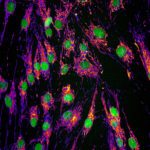Link to Pubmed [PMID] – 26754340
Trends Endocrinol. Metab. 2016 Feb;27(2):105-117
Mitochondrial morphology varies tremendously across cell types and tissues, changing rapidly in response to external insults and metabolic cues, such as nutrient status. The many functions of mitochondria have been intimately linked to their morphology, which is shaped by ongoing events of fusion and fission of outer and inner membranes (OM and IM). Unopposed fission causes mitochondrial fragmentation, which is generally associated with metabolic dysfunction and disease. Unopposed fusion results in a hyperfused network and serves to counteract metabolic insults, preserve cellular integrity, and protect against autophagy. Here, we review the ways in which metabolic alterations convey changes in mitochondrial morphology and how disruption of mitochondrial morphology impacts cellular and organismal metabolism.

